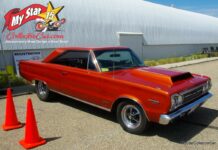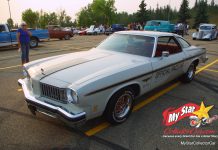Tires are always a hot button with car guys, and it breaks down into two camps.
The ‘keep it completely original’ camp and the ‘make it a better driver’ camp are the two opposing forces.
I have some thoughts on this touchy subject based on sketchy memories combined with some basic research on what tires were correct back in the golden era.
Jerry Sutherland
I have to start with lettered tires because that’s where I draw the line on correct versus what looks cooler.

The truth is 1969 was the pivotal year for lettered tires. Purists will tell you lettered tires showed up much earlier on race cars, but most people were driving cars to the grocery store in the 50s—not at Indianapolis Speedway.

There was a period when whitewalls and letter tires overlapped–then letter tires became far more common on cars like Vettes, Cudas and Trans Ams. That’s a long way to a short point. If you’re trying to recreate a ’66 Chevelle SS 396, skip the lettered tires–or trade it for a ’70 Chevelle .

Blackwalls are another world of tires.
Blackwall tires have been around as long as cars, so you won’t go wrong with blackwalls—to a point. I co-invested in a ’62 Lincoln years ago and the thing that really stood out were the blackwall tires because a ’62 Lincoln was definitely not a blackwall tire car.

You could make a case now for blackwalls on a ’62 Lincoln because these cars roll with giant wheels and rubber band tires in the 21st century but back in the early 60s that’s the last thing you’d see on a Lincoln.

For me, the ultimate blackwall car is the ’68-9 Road Runner two-door post. These cars were the definition of barebones, so the blackwall lines up perfectly with its budget muscle car image.

The same rule applies to most base model sedans because whitewalls were a frivolous option to a budget-oriented car buyer. In my opinion, a barebones sedan looks tougher with blackwalls—more business and less glamor.

Giant whitewalls—unlike blackwalls—definitely have a best-before date.
Big whitewall (white sidewall or WSW) tires were the go-to option for luxury cars in the 1920s so you’d see them on Cadillacs, Packards, Deusenbergs—any car that would attract a high-end buyer.

They looked perfect on these massive cars, so you’d also see them on lower-end cars like Chevy, Ford, and Plymouth if the owner wanted to cough up a little more cash.

The big WSW peaked in the 50s, but by the early 1960s the big whitewall option was gone—unless you drove a Lincoln. You’ll still see them on customs and retro-rides, but you won’t see a big whitewall on a Toyota or Ram truck.

Redline tires had a short, but spectacular life in the mid-60s.

They were the perfect option for cars back in an era when The Monkees were a huge force in music. I remember the first time I saw a redline tire on a new GTO and it blew me away with its cool factor.

The redline tire was around as a force until the late 60s, when the letter tires debuted– but in my opinion they should have stuck around longer.

You’ll see versions of the redline on some retro-customs and import cars, but they are like flower power shirts from a distinct piece of 60s history. The redline tire deserved better.
Opinions on tires are like opinions on politics—you have your camp but someone else may have another camp–don’t turn it into a brawl. We’re bigger than that.
Jerry Sutherland
By: Jerry Sutherland
Jerry Sutherland is a veteran automotive writer with a primary focus on the collector car hobby. His work has been published in many outlets and publications, including the National Post, Calgary Herald, Edmonton Journal, Ottawa Citizen, Montreal Gazette, Saskatoon StarPhoenix, Regina Leader-Post, Vancouver Sun and The Truth About Cars. He is also a regular contributor to Auto Roundup Publications.
- CLICK HERE TO SIGN UP FOR THE NEWSLETTER
- CLICK HERE to Like us on Facebook
- CLICK HERE to Follow us on Twitter
- CLICK HERE to Follow us on Pinterest
Please re-post this if you like this article.
























































